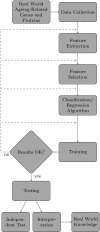A review of supervised machine learning applied to ageing research
- PMID: 28265788
- PMCID: PMC5350215
- DOI: 10.1007/s10522-017-9683-y
A review of supervised machine learning applied to ageing research
Abstract
Broadly speaking, supervised machine learning is the computational task of learning correlations between variables in annotated data (the training set), and using this information to create a predictive model capable of inferring annotations for new data, whose annotations are not known. Ageing is a complex process that affects nearly all animal species. This process can be studied at several levels of abstraction, in different organisms and with different objectives in mind. Not surprisingly, the diversity of the supervised machine learning algorithms applied to answer biological questions reflects the complexities of the underlying ageing processes being studied. Many works using supervised machine learning to study the ageing process have been recently published, so it is timely to review these works, to discuss their main findings and weaknesses. In summary, the main findings of the reviewed papers are: the link between specific types of DNA repair and ageing; ageing-related proteins tend to be highly connected and seem to play a central role in molecular pathways; ageing/longevity is linked with autophagy and apoptosis, nutrient receptor genes, and copper and iron ion transport. Additionally, several biomarkers of ageing were found by machine learning. Despite some interesting machine learning results, we also identified a weakness of current works on this topic: only one of the reviewed papers has corroborated the computational results of machine learning algorithms through wet-lab experiments. In conclusion, supervised machine learning has contributed to advance our knowledge and has provided novel insights on ageing, yet future work should have a greater emphasis in validating the predictions.
Keywords: Ageing; Model interpretation; Supervised machine learning.
Figures
Similar articles
-
A review of active learning approaches to experimental design for uncovering biological networks.PLoS Comput Biol. 2017 Jun 1;13(6):e1005466. doi: 10.1371/journal.pcbi.1005466. eCollection 2017 Jun. PLoS Comput Biol. 2017. PMID: 28570593 Free PMC article. Review.
-
Iterative processes: a review of semi-supervised machine learning in rehabilitation science.Disabil Rehabil Assist Technol. 2020 Jul;15(5):515-520. doi: 10.1080/17483107.2019.1604831. Epub 2019 Jul 8. Disabil Rehabil Assist Technol. 2020. PMID: 31282778 Review.
-
Accurate in silico identification of protein succinylation sites using an iterative semi-supervised learning technique.J Theor Biol. 2015 Jun 7;374:60-5. doi: 10.1016/j.jtbi.2015.03.029. Epub 2015 Apr 2. J Theor Biol. 2015. PMID: 25843215
-
DOME: recommendations for supervised machine learning validation in biology.Nat Methods. 2021 Oct;18(10):1122-1127. doi: 10.1038/s41592-021-01205-4. Nat Methods. 2021. PMID: 34316068 No abstract available.
-
A semi-supervised machine learning framework for microRNA classification.Hum Genomics. 2019 Oct 22;13(Suppl 1):43. doi: 10.1186/s40246-019-0221-7. Hum Genomics. 2019. PMID: 31639051 Free PMC article.
Cited by
-
Artificial Intelligence for Mental Health and Mental Illnesses: an Overview.Curr Psychiatry Rep. 2019 Nov 7;21(11):116. doi: 10.1007/s11920-019-1094-0. Curr Psychiatry Rep. 2019. PMID: 31701320 Free PMC article. Review.
-
Artificial intelligence in critical care: Its about time!Med J Armed Forces India. 2021 Jul;77(3):266-275. doi: 10.1016/j.mjafi.2020.10.005. Epub 2021 Mar 18. Med J Armed Forces India. 2021. PMID: 34305278 Free PMC article. Review.
-
Aging Atlas: a multi-omics database for aging biology.Nucleic Acids Res. 2021 Jan 8;49(D1):D825-D830. doi: 10.1093/nar/gkaa894. Nucleic Acids Res. 2021. PMID: 33119753 Free PMC article.
-
The multiple uses of artificial intelligence in exercise programs: a narrative review.Front Public Health. 2025 Jan 31;13:1510801. doi: 10.3389/fpubh.2025.1510801. eCollection 2025. Front Public Health. 2025. PMID: 39957989 Free PMC article.
-
Epigenetic clocks reveal a rejuvenation event during embryogenesis followed by aging.Sci Adv. 2021 Jun 25;7(26):eabg6082. doi: 10.1126/sciadv.abg6082. Print 2021 Jun. Sci Adv. 2021. PMID: 34172448 Free PMC article.
References
-
- Brewer GJ. Iron and copper toxicity in diseases of aging, particularly atherosclerosis and Alzheimers disease. Exp Biol Med. 2007;232(2):323–335. - PubMed
-
- de Magalhães JP. An introduction to gerontology. 1. Cambridge: Cambridge University Press; 2011. The biology of ageing: a primer; pp. 22–47.
-
- de Magalhães JP, Tacutu R. Chapter 9: Integrative genomics of aging. In: Martin GM, Kaeberlein MR, editors. Handbook of the biology of aging (Eighth Edition) New York: Academic Press; 2016. pp. 263–285.
Publication types
MeSH terms
LinkOut - more resources
Full Text Sources
Other Literature Sources
Medical
Miscellaneous



